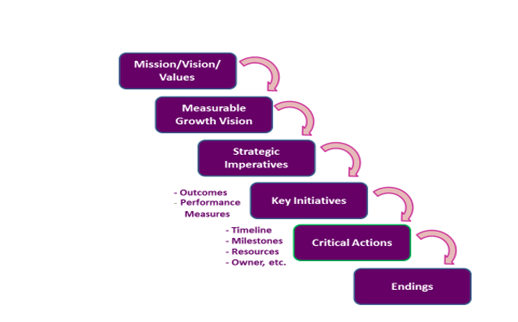ATD Blog
Winning Talent Development Firms Put Together a Strategic Plan
Tue Nov 22 2022

Assuming you understand the dynamics of your industry, know what you want and need out of your business, appreciate why you are doing it in the first place, and figured out the structure of your operation, it is time to think about your long-term plan to success. Put together a strategic plan to accomplish the manifestation of your vision, values, and mission for the business. A strategic plan lays out the steps required to get from here to there. While a plan alone doesn’t achieve anything in itself, it is the first step to setting the stage for execution. It is often said that a strategic plan without execution is misaligned, but it’s also true that execution without strategy is misdirected. They work in tandem to achieve success.
In this blog, however, I will focus only on the planning process by first distinguishing strategic planning from strategic thinking, and then providing a simple step-by-step procedure for creating the plan.
Strategic Planning vs. Strategic Thinking
Often, strategic planning and strategic thinking get confused even though the two concepts are very different. It’s hard to imagine creating an effective plan without the capacity to think strategically. But it is also difficult to think strategically without some context for what comes next. In a nutshell:
Strategic thinking is the what and why of the planning process and a way of envisioning the ongoing big picture.
Strategic planning is the how, when, and who of the planning process and a way of acting periodically to review, focus, and implement.
As noted in the table, we can further distinguish these two concepts by comparing them in four ways: purpose, process, needed skill set, and toolkits required.
Factor | Strategic Thinking | Strategic Planning |
Purpose | Discover novel imaginative strategies. | Operationalize strategies. |
Process | Incorporate innovative and creative ideation to develop strategies. | Envision the future and translate it into goals, objectives, and steps. |
Skill Set | Apply visionary, creative, and imaginative skills. | Employ organization, prioritization, and executive skills. |
Toolkit | Use brainstorming, scenario planning, and root cause analyses. | Use Gantt charts, utility analyses, task lists, and job descriptions. |
Another way to compare the two concepts is to recognize that without strategic planning, strategic thinking results in a continuing quest for structure and process because it informs strategic planning. But without strategic thinking, strategic planning results in a lifeless process of setting goals and measuring objectives because it lacks the voice, action, and creativity of strategic thinking. |
What does this mean in practice? Both processes must be present to map out a journey to success.
A Strategic Planning Process
To make the two come alive requires taking full advantage of thinking and planning. We can accomplish this by following six sequential steps, as noted in this figure.

We’ve already discussed mission, vision, and values in a previous blog, so we must convert those into metrics that will provide us with a measurable growth vision, or outcome, to gauge our periodic success. Once we’ve established this desired outcome, we must determine three to five strategic imperatives that, when properly executed, result in the desired outcome. We need to also establish three to five key initiatives for each strategic imperative. These are the projects or activities that must be put in place to ensure each strategic imperative is accomplished over time. Likewise, each key initiative can be further defined by the specific critical actions that detail the who, what, and when for each key initiative.
Finally, there are many activities occurring in the business unrelated to achieving the overall growth vison. In fact, most of them are likely to hinder success. These are the endings that must be halted so that the time, energy, and resources devoted to them can be preserved for what’s more important and directly related to accomplishing the strategic plan.
If this seems like a detailed and taxing process, indeed it is, as nothing good comes without hard work and deep thinking. But sustainable success comes with a well-thought out plan that maps the future and documents how it will be effectively and efficiently achieved.
You've Reached ATD Member-only Content
Become an ATD member to continue
Already a member?Sign In
